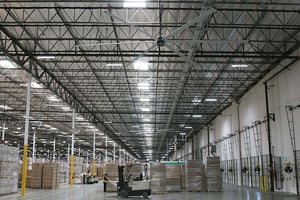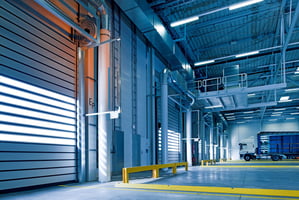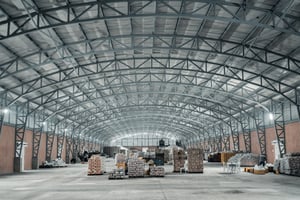Warehouses and logistics facilities generally encompass massive square footage. They are filled...
5 Steps to Easily Balance Temperature in Your Warehouse or Factory
Warehouses, factories, agricultural buildings, and other industrial buildings all can eat up a lot of air conditioning. Even with the use of HVAC blowing cool air, many facilities still do not have a constant temperature throughout. Drafts, lighting, insulation, and architectural layout will create mini-climate zones. If you want to save money on energy and balance the temperature in your warehouse consider these steps.
5 Steps to Easily Balance Temperature in Your Warehouse or Factory
- Step 1: Open the Doors
Opening doors to the north and south invites a natural airflow. Industry expert Jason Hornsby refers to this as "gravity ventilation." Says Hornsby,
"Getting air in and out of your building is key. Getting the hot air out, getting fresh air in, that always helps. The inside air will rise above the "cooler" outside air. But, you also risk changing the quality of the air."
Even the gravity ventilation will favor areas close to the doors, and while wall fans might push the air around, it will not reach all corners or regions of the building. Outside air will not reach well inside the building without assistance, and that adds cost. - Step 2: Open Windows
Absent other resources, when you open windows located high on walls or vents in roofs, you let the heat climb and exit. The physics of this makes room for incoming cooler air. But, in oppressive heat, this movement will also reach a point of diminishing returns where there is little or no movement felt. According to Hornsby's experience, "A lot of people, they're not happy with that scenario by itself because they don't feel the air." - Step 3: Build Smart
Unless there is a functional necessity, you do not want to design a floor plan with nooks and crannies, warrens of cubicles, or closely packed heat-emitting equipment. If dock platforms and large doors are part of the equation, you need to chamber their access, so they do not drain the air indoors. Well-placed fans can build a temperature barrier that separates the indoor and outdoor climate zones. - Step 4: Manage the Air
Air will form layers, horizontally and vertically. Floor fans, pedestal fans, and wall fans will push the layered air, but they will not change it. If you visualize the air as a block, those traditional fans will move the block about the building. And, if you place the fans strategically, the block will move here and there as planned. But, you are still moving hot air around. You cannot truly de-stratify the air without the inclusion of high volume, low speed (HVLS) fans to "break up your heat layers," notes Hornsby. - Step 5: Get Ahead of the Heat
The HVLS fans will move such a large volume of air - a column of air the height of the building - to the floor where it will create a jet of air across the building's floor to the walls. At the walls, the warmed air will rise again, to be blown to the floor once again. This cycle actually alters the molecular makeup of the air - blending, rearranging, cleaning, and more.
When you let these low-cost HVLS fans run 24/7 to do their work ahead of the heat, Jason Hornsby remarks, "You don't let the layers build up, so you don't have to break them up." Some of the latest fans even include internal "brains" to regulate run schedules and integrate with existing cooling systems where applicable.
Summary
Facility managers, operations directors, building architects, and engineers alike want to optimize their energy dollars and resources to control building temperatures. It is crucial for the comfort of their occupants and the success of their business. Advances in HVLS fan technology support the strategic integration of natural cooling resources and HVAC systems to balance temperature in your warehouse.
This blog post utilized content from a subject matter expert interview with Jason Hornsby. Hornsby is the owner/ President of Vector Sales and the Regional Sales Rep for MacroAir Fans. An expert with high volume, low-speed fans, Jason has spent more than 22 years focused on cooling solutions for industrial facilities that increase employee comfort and decrease energy consumption.
Find the Perfect Big Fan for Your Warehouse


